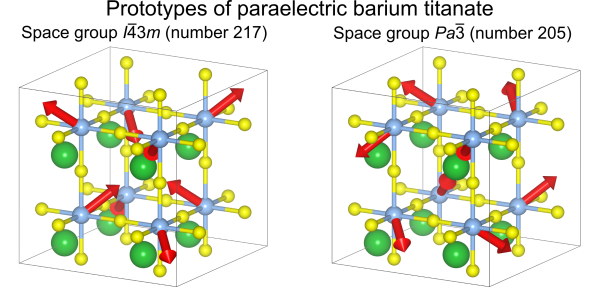Researchers identify new paraelectric phase prototypes for use in computational engineering of functional materials
by Carey Sargent, EPFL, NCCR MARVEL
Perovskites—that is, a material with a crystal structure following the formula ABX3, where X atoms are commonly oxygens which form an octahedral cage around B atoms —are versatile materials that can exhibit a wide range of properties such as superconductivity, catalysis, photovoltaic energy harvesting and ferroelectricity, giving them potentially broad applications and relevance.
Ferroelectrics exhibit spontaneous polarization that can be switched with an electric field. As the temperature is raised, they move to a paraelectric phase—the material generates dielectric polarizations when an electric field is applied, and then loses them when the electric field is removed. Early studies of the prototypical ferroelectric perovskite BaTiO3 suggested a “displacive" model in which local displacements of the B-cation (titanium) align with macroscopic polarization as the temperature decreases below the ferroelectric phase transition. The problem is, results from diffuse X-ray scattering experiments don’t really support this model, except for the ground-state rhombohedral phase.

Figure 1: The two prototypes for cubic paraelectric barium titanate identified using the symmetry analysis based on group-subgroup relations in tandem with first-principles calculations detailed in the work of Kotiuga et al. These prototypes, both energetically and dynamically stable, can serve as minimal microscopic models of the paraelectric phase as they provide a faithful microscopic representation with key features: the persistence of local titanium displacements and the appropriate macroscopic point group. The barium, titanium, and oxygen atoms are shown in green, blue, and yellow, respectively. The red arrows indicate the direction of titanium displacements. For clarity, the oxygen displacements are not displayed.
This led to the development of an “order-disorder” model, which suggests that local polar displacements are in various ordered arrangements in ferroelectric phases at low temperatures before becoming disordered in the paraelectric phase. Studies have shown that BaTiO3 supercells that possess certain Ti displacements and maintain the experimentally-observed macroscopic polarization are energetically favorable and dynamically stable.
To investigate the microscopic picture of paraelectricity in these perovskites further, NCCR MARVEL researchers Michele Kotiuga, Nicola Marzari and Giovanni Pizzi at EPFL and colleagues from Designed Material Technologies, LLC; Harvard University; Robert Bosch LLC and Central Michigan University performed simulations using the first-principles Car-Parrinello molecular dynamics (CPMD) technique. In the paper “Microscopic picture of paraelectric perovskites from structural prototypes,” they report clear microscopic evidence of such displacements, or off-centerings, and associated dipoles in their simulations of cubic BaTiO3. These displacements persist well above the Curie temperature, consistent with the order-disorder model. They also found that these displacements can be suppressed with compressive hydrostatic strain, showing good agreement with previous experimental characterizations.
Inspired by these results, the researchers went on to systematically identify the smallest supercells with cubic point symmetry that are both energetically and dynamically stable, referring to them as the microscopic structural prototypes of this paraelectric phase. They identified two cubic prototypes, one previously unknown, through a symmetry analysis exploring all possible 40-atom microscopic templates and then assessed energetic and dynamic stability through DFT and density-functional perturbation theory calculations.
“Under the right conditions, the prototypes can serve as minimal models of the paraelectric phase in first-principles calculations of response functions because they provide a faithful microscopic representation with the essential features of the persistence of local Ti displacements and the appropriate macroscopic point group,” Kotiuga said, going on to emphasize that the approach is general. “It can be extended to study the prevalence of the B-site off-centerings in ABO3 perovskites, but even beyond that could be used in any crystalline system to find candidate templates and efficiently search for prototypes that are local minima in the potential-energy surface. This would provide and in-depth study of, e.g., the electronic or magnetic properties of a polymorphic system.”
“The approach also lays the foundation for investigating dynamics, thermodynamics and chemical substitutions,” Pizzi added. “These prototypes could be used to capture details of the energy landscape and to provide models for studying the properties or transitions of disordered phases such as alloys, paramagnetic phases, or defects in paraelectric phases.”
Reference:
Michele Kotiuga, Samed Halilov, Boris Kozinsky, Marco Fornari, Nicola Marzari, and Giovanni Pizzi. Microscopic picture of paraelectric perovskites from structural prototypes. Phys. Rev. Research 4, L012042
Low-volume newsletters, targeted to the scientific and industrial communities.
Subscribe to our newsletter